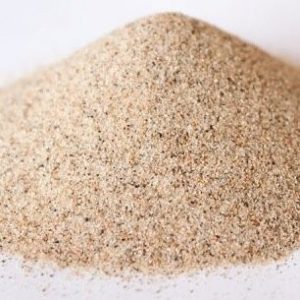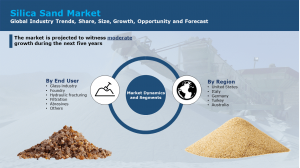Silica sand, also known as quartz, is a highly durable and chemically stable silicate mineral primarily composed of SiO2. It comes in various forms, such as synthetic silica sand, water-washed sand, scrubbed sand, and selected (flotation) sand, each differing based on mining and processing methods. High-purity silica sand is milky white, while impurities render it light brown. Its melting point is around 1750°C, with particle sizes ranging from 0.02 mm to 3.35 mm, making it insoluble in all acids except hydrofluoric acid. Silica sand’s excellent chemical stability, electrical edge, and wear resistance make it indispensable in multiple industries including glass manufacturing, ceramics, construction, electronics, and water treatment. The global silica sand market, valued at US$ 17.4 billion in 2020, is projected to grow at a CAGR of 6.2% from 2021 to 2026, driven by the booming glass industry and technological advancements.
Start a Business in Mining Industry, Click Here
The silica sand with excessive purity is milky white. When the impurity content material is more, the silica sand might be brown and mild brown. The melting factor of silicon sand is set 1750 C, the particle length is among 0.02mm and 3.35mm, and it's far insoluble in acid besides for hydrofluoric acid. It has top chemical stability, electric powered edge, and put on resistance.

Related Projects- Minerals, Marble, Granite, Gypsum, Quartz, Talc, Mica
Silicon sand is an vital commercial mineral uncooked material, broadly utilized in glass, casting, ceramics and refractory substances, metallurgy, construction, machinery, electronics, chemical, plastic, abrasive, rubber, aerospace and different industries. Another vital use of silica sand is the clear out and clear out used for water treatment.
Usage of Silica Sand:
1) Glass: flat glass, go with the flow glass, glass products (glass jars, glass bottles, glass tubes, etc.), optical glass, glass fiber, glass instrument, conductive glass, glass fabric and unique glass for anti-ray
2) Ceramics and refractories: porcelain substances and glazes, excessive silica bricks, regular silica bricks and silicon carbide uncooked substances.
3) Metallurgy: uncooked substances or components and fluxes of silicon metallic, ferrosilicon alloy and silicon aluminum alloy.
4) Construction: concrete, cementitious material, avenue constructing material, synthetic marble, cement bodily belongings check material (particularly cement popular sand)
Related Books- Minerals & Mineral Processing, Glass and Ceramics
5) Chemical: silicon compound and water glass and different uncooked substances, sulphuric acid tower filling, amorphous silica powder.
6) Machinery: the principle uncooked substances for casting sand, abrasive substances (sandblasting, difficult abrasive paper, sandpaper, abrasive fabric, etc.)
7) Electronics: excessive purity metallic silicon, optical fiber for communication, etc.
8) Rubber and plastics: fillers (boom put on resistance)
9) Aeronautics and Astronautics: its inner molecular chain structure, crystal form and lattice extrude law, with excessive-temperature resistance, low thermal enlargement coefficient, corrosion resistance, excessive insulation, piezoelectric impact, resonance impact and its precise optical properties.
Related Video- Minerals, Marble, Granite, Gypsum, Quartz, Talc, Mica Projects
Market Growth of Silica Sand Globally:-
The international silica sand marketplace reached a fee of US$ 17.four Billion in 2020. Looking forward, the marketplace is anticipated to develop at a CAGR of 6.2% at some point of 2021-2026. The glass marketplace is experiencing excessive increase because of accelerated call for from the development marketplace, growing car manufacturing and sales, mounting according to capita income, and technological advancements. Besides this, rising developments including growing utilization of hybrid manual plate, sun manipulate glazing for car and constructing glasses, light-weight glazing glass, and superior nanotechnology in flat glass also are contributing toward the increase of the glass industry, consequently, boosting the call for silica sand.
Start a Business in Potential Countries for Doing Business, Click Here
Best Industry for Doing Business, Click Here

The development of The Nimes-Montpellier rail bypass, Grand Paris Express, Tour Triangle and the ASVEL area in France are expected to reinforce the silica sand marketplace increase.
Business Ideas with Low, Medium & High Investment, Click Here
Looking for Most Demandable Business Ideas for Startups, Click Here
Conclusion:-
The project report of NPCS include detailed analysis that help to get industry present market position and expected future demand. Offer real analysis driving variables for the business and most recent business sector patterns in the business. The project report gives investigation and top to bottom money related correlation of real players/competitors. Furthermore the report gives gauges of key parameters which foresees the business execution.
Start a Business in Africa, Click Here
Start a Business in India, Click Here
Start a Business in Middle East, Click Here
Start a Business in Asia, Click Here
Frequently Asked Questions (FAQs) about Silica Sand
What is silica sand, and what are its main components?
Silica sand, also known as quartz sand, is a durable and chemically stable silicate mineral primarily composed of silicon dioxide (SiO2).
What are the different types of silica sand based on mining and processing methods?
Silica sand can be categorized into synthetic silica sand, water-washed sand, scrubbed sand, and selected (flotation) sand, each differing by their mining and processing techniques.
What industries commonly use silica sand, and why is it important?
Silica sand is vital in industries such as glass manufacturing, ceramics, construction, electronics, and water treatment due to its chemical stability, durability, and various beneficial properties.
How does the purity of silica sand affect its color and applications?
High-purity silica sand is milky white, while silica sand with impurities appears light brown. Purity levels impact its suitability for different applications, such as high-quality glass production.
What is the market outlook for silica sand, and what factors are driving its growth?
The global silica sand market is expected to grow at a CAGR of 6.2% from 2021 to 2026, driven by increased demand from the glass industry, advancements in technology, and rising use in various industrial applications.